Key Insights
- Flexa supports over 99 cryptocurrencies across 12 blockchain networks.
- AMP is the collateral token that facilitates decentralized transactions.
- Stakers are rewarded with AMP for every transaction on the network.
- Spending capacity TVL is $377 million as of May 16, 2022.
Digital payment rails have existed in retail and institutions for decades. However, the evolution of these rails has developed much slower than the cutting-edge technology that uses it. Although the world continues to witness the mass adoption of cryptocurrencies and digital assets, users experience limitations on how to spend their preferred forms of payment. Currently, most methods of engaging in cryptocurrency transactions are not very transparent and involve exchanging digital assets for fiat through centralized exchanges, which can cause a logistical challenge. Flexa is a digital payments network that provides merchants with seamless options to facilitate cryptocurrency payments from various mobile applications and digital wallets. Flexa achieves this by using a hybrid-approach utilizing a centralized framework and a decentralized network, the Flexa network.
Background
Flexa was founded in early 2018 by Tyler Spalding, Zach Kilgore, Trevor Filter, and Daniel McCabe and is headquartered in New York. Their mission was to innovate the traditional payments infrastructure, address the social impact of costly transaction fees, and eliminate fraudulent payments by utilizing the benefits of smart contracts on the decentralized blockchain network, Ethereum.
Flexa Network
The Flexa network is a digital payments network that supports over 99 cryptocurrencies across 12 blockchain networks, supporting over 41,000 merchants. The payments network was developed to remove costly intermediaries and enable the universal acceptance of various digital assets by integrating with existing payments infrastructure at the point-of-sale (POS). In real time, Flexa’s payment solutions facilitate instant, economical, and fraud-proof settlements in-store, online, or through mobile applications.
Flexa utilizes existing centralized payment infrastructure like merchant POS systems, online, and mobile applications to facilitate transactions. However, Flexa’s hybrid approach incorporates decentralized networks as a settlement layer to authenticate and validate transactions on-chain. Being on-chain eliminates the need for financial intermediaries and reduces transaction costs related to fraud, all while preserving transaction security and privacy.
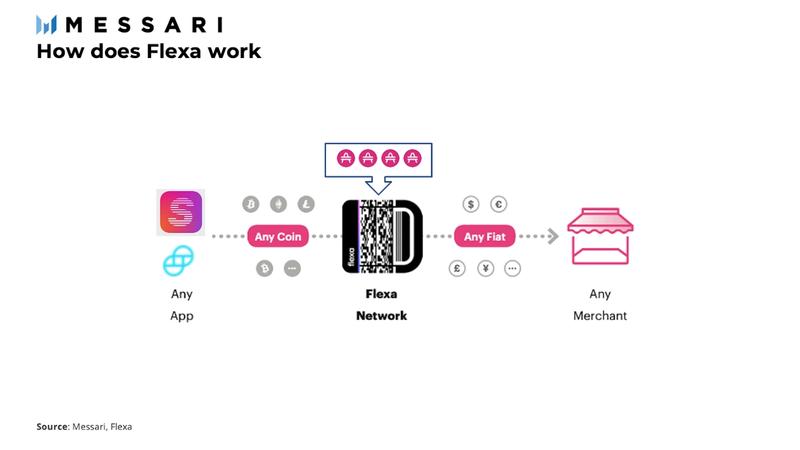
Flexa Network Mechanics
The centralized infrastructure of the Flexa network integrates with existing global payment platforms through strategic global payments partnerships. It also adheres to local regulatory frameworks, ensuring a fully licensed, compliant, and legal digital payments system. The Flexa Spend SDK (Software Development Kit) and Payment Links API allows developers and merchants to seamlessly integrate Flexa’s digital payment features to their POS systems and different platforms.
Users can interface with Flexa-enabled applications like SPEDN or Gemini by depositing supported cryptocurrencies (note: SPEDN only supports deposits at the moment). Through the app, they select a merchant and any cryptocurrency with a balance they want to transact in. Flexa-enabled apps generate a one-time unique QR or “flexacode” that is scanned by merchants to authenticate and settle the transaction. Alternatively, supported merchants can create a QR code which is scannable by any wallet using the Payment Links product. Upon settlement, the merchant receives funds in fiat or a cryptocurrency of their choice. The Flexa network enables a transaction flow that eliminates various intermediaries like payment gateways, payment and card processors, and acquiring and issuing banks. All this is made possible by incorporating Flexa’s decentralized approach.
The decentralized network is composed of permissionless collateral pools. Global participants can provide liquidity to these pools through staking, which is used to collateralize transactions made on the network. Flexa’s collateral token, Amp, is an ERC-20-compatible token used as a singular type of collateral for staking in these collateral pools. This token decentralizes transaction risk on the Flexa network.
When transactions are initiated at the POS and users scan the Flexacode, the Amp from the collateral pool is locked against the fiat value of the purchase. Flexa uses a decentralized price oracle, Chainlink, to capture the locked conversion price of the chosen cryptocurrency and Amp token.
Because the time necessary to reach final settlement can vary depending on the underlying asset, Amp is locked as collateral in Flexa Capacity smart contracts. The collateral is released once the transaction reaches economic finality on-chain and again becomes available to use as collateral. This decentralized approach reduces transaction risk and merchant fees, as well as eliminating fraudulent activity.
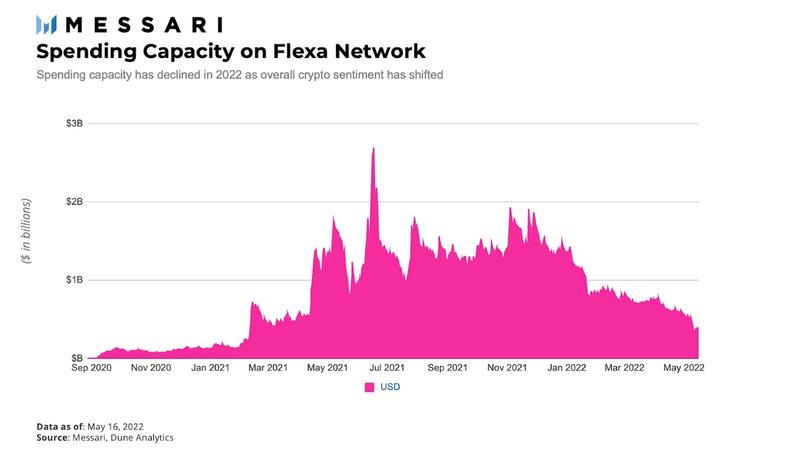
Token, Usage, and Supply Dynamics
Flexa and Consensys designed the Amp token to be an extensible and open-source token purpose-built for collateral. They introduced a novel approach to the existing ERC-20 framework by incorporating collateral managers and token partitions, which make the AMP token stand out from traditional ERC-20 tokens. Anyone using Amp as collateral to transfer value or escrow services can create a collateral manager, giving them the flexibility to create custom specifications for various use cases. Additionally, token partitions enable collateral managers to allow users to preserve asset custody when tokens are staked, removing the need to transfer collateral to other smart contracts.

Collateral managers are effectively smart contracts that manage collateral pools used to secure transaction activity for a specific purpose (e.g. spending on Flexa). The available spending capacity on the Flexa network is unique to each collateral pool and is driven by the fiat value of Amp staked in each pool. If collateral managers have insufficient collateral pools relative to their transaction volume, they will be unable to support transactions on the Flexa network. Users can go to the Flexa Capacity application and stake Amp to 14 permissionless collateral pools.
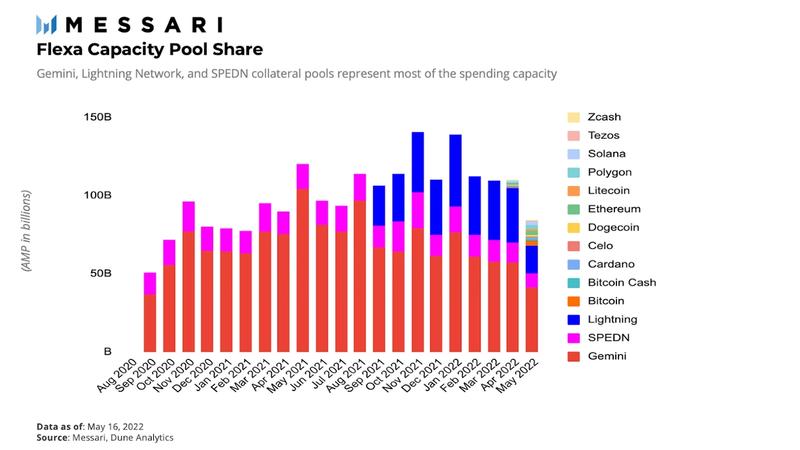
Tokenholders who stake their Amp in collateral pools are rewarded with Amp tokens whenever merchant fees are generated through settled transactions. These fees are used to purchase Amp in the open market and are distributed pro rata to stakers. The Amp token rewards are exclusive to participants of each unique collateral pool that is used to secure the settlement.
The network effect of Amp reward distribution is an incentive for stakers. Participants seeking rewards long-term effectively reduce the circulating supply, which can add supply pressure to the Amp token. As Flexa onboards more collateral managers, the competition for collateral can also increase due to the need for a sufficient collateral pool to support transaction activity.
The risks that exist within the Flexa network revolve mostly around oracle risk, collateral manager risk, and smart contract risk. Flexa uses the price feed from Chainlink’s price oracle when transactions are locked up. If the oracle were ever inaccurate, the Flexa network would inadvertently impact the user and/or merchant. Collateral manager risk exists if a new merchant or mobile application facilitates malicious behavior, which could lead to a collateral slashing event. Lastly, vulnerabilities within smart contracts could pose a risk of losing or freezing assets.
Supply Curve
Amp has a maximum fixed supply of 100 billion tokens and is the replacement of Flexacoin, which was fully migrated for a 1:1 exchange to support the additional features built within the Amp token such as token partitions. The entire token supply is allocated to be used through 2045 and doesn’t possess any native burn functions.
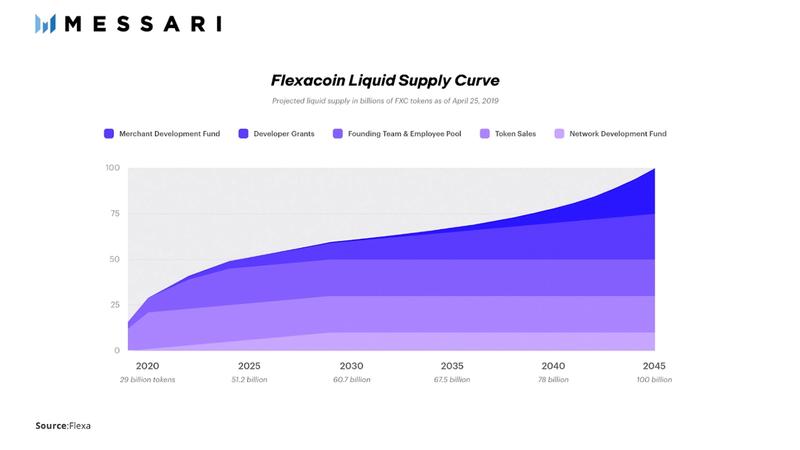
- The Merchant Development fund received 25% of the fixed supply with the sole purpose of supporting merchant integrations. These tokens were reserved in efforts to facilitate merchant acceptance of Flexa-enabled applications, including hardware and software deployment
- Developer Grants received 25% of the fixed supply to help increase adoption of Amp for payment collateralization. Starting in January 2020, 1 billion AMP will be allocated each year to developers interested in enabling Amp collateralized payments on their applications. These tokens will be stake-locked for a period of 12 months upon granting, after which they will be unlocked for general circulation by recipients.
- The Founding Team and Employee pool was allocated 20% of the fixed supply to incentivize current and future Flexa team members. This allocation will be distributed over a four-year vesting schedule with a one-year cliff in order to ensure ongoing involvement with the project.
- A total of 20% of the fixed supply was allocated Token Sales, which include all tokens that have been externally distributed.
The remaining 10% of the fixed supply was allocated to the Network Development fund. The fund will be used to support the development of the Flexa network over the first decade of its operation, which will be disbursed at a rate of 1 billion tokens per year.

Governance and Voting
Governance takes place off-chain via Snapshot, which is a gas-less signature platform. The requirement for submitting valid proposals is a minimum of 1 billion AMP (1% of token supply). A quorum of 5 billion AMP (5% of token supply) must be achieved for a vote to be successful, and a vote must be active for a minimum of 48 hours. Voters have the ability to propose grant programs, DeFi partnerships, and the onboarding of new mobile applications or wallets.
Additionally, Amp tokens must be held directly or staked in an approved collateral contract for voting eligibility. Newly onboarded collateral managers can be approved through the governance process. Tokenholders who do not meet the minimum token requirements but want to engage in proposals are encouraged to communicate through the proper channels and propose suggestions.
The Amp token that drives the Flexa network has been audited on three occasions by leading smart contract auditing firms Consensys Diligence and Trail of Bits. (Trail of Bits 8/3/2020, Consensys Diligence 6/19/2020, and Trail of Bits 9/20/2019)
Governance takes place off-chain via Snapshot, which is a gas-less signature platform. The requirement for submitting valid proposals is a minimum of 1 billion AMP (1% of token supply). A quorum of 5 billion AMP (5% of token supply) must be achieved for a vote to be successful, and a vote must be active for a minimum of 48 hours. Voters have the ability to propose grant programs, DeFi partnerships, and the onboarding of new mobile applications or wallets.
Additionally, Amp tokens must be held directly or staked in an approved collateral contract for voting eligibility. Newly onboarded collateral managers can be approved through the governance process. Tokenholders who do not meet the minimum token requirements but want to engage in proposals are encouraged to communicate through the proper channels and propose suggestions.
The Amp token that drives the Flexa network has been audited on three occasions by leading smart contract auditing firms Consensys Diligence and Trail of Bits. (Trail of Bits 8/3/2020, Consensys Diligence 6/19/2020, and Trail of Bits 9/20/2019)
Partnerships & Grants Program
Merchant Partnerships — Nordstrom, Barnes & Noble, Lowe’s, GameStop, and Regal Cinema are among some notable merchants that accept Flexa Payments
Point-of-Sale Partnerships — InComm Payments, NCR, Blackhawk Network, Citcon, GK, Clover, Shopify, Woo Commerce, PrestaShop, Magento, Opencart, Drupal Commerce, Rooam, and Aurus
AMP-Supported Wallets — Coinbase, Exodus, Gnosis Safe, Guarda Wallet, Krystal, Metamask, Rainbow, and Trust Wallet
The Flexa Developer Grants Program (FDGP) offered ten participants early access to the new Flexa Spend SDK (Software Development Kit) product which allows for a seamless integration and unlocking of AML compliant payment functionality across merchant payment applications. Developers involved in the FDGP will receive 10 million AMP, which will be staked in their collateral pool when their integrations go live.
The 10 FDGP participants announced in April 2022 include: Argent, Leap, Litewallet, Dashwallet, Nighthawkwallet, Valora, Nodewallet, Cryptostars, Airgap Wallet, and Eternl.
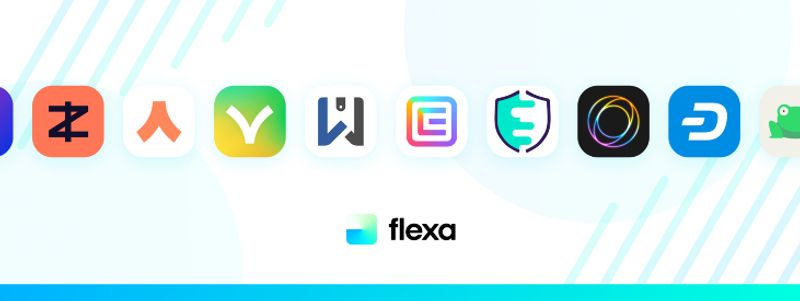
Competition, Obstacles, Traction, and Roadmap
There are various competitors like Circle Payments, Solana Pay, Nuvei, CoinPayments, MercurYo, and BitPay that all facilitate crypto transactions. Although Solana Pay can transact in any Solana Project Library (SPL) token, its focus is on Circle’s USDC stablecoin. Nuvei, CoinPayments, MercurYo, and Bitpay are also successful crypto-payment competitors; however, they operate entirely in a centralized manner.
Flexa differentiates itself from its competition by providing an open-source network utilizing a hybrid centralized/decentralized approach to integrate with merchants’ existing payment solutions, materially reducing the barriers to entry for merchants, wallets, and applications.
Flexa introduces a cost-effective way for entities of all shapes and sizes to use Flexa Payment products. It offers compatibility with more cryptocurrencies and blockchain networks than any other digital currency payments providers.
Regulation is often an obstacle for payment solutions due to the stringent regulations that exist today. However, Flexa is fully licensed and legally authorized to operate throughout the nation and boasts an AML/KYC-compliant network, instilling confidence in participating and prospective partnerships.
Flexa’s goal is to expand their Flexa Payment platform by including the Payments API for custom integrations later in the year. Flexa plans to onboard new strategic partnerships, users, mobile applications and wallets and achieve net-zero emissions by 2025.
Conclusion
The Flexa team has been making strides and driving the needle in crypto payment solutions since 2018. The Flexa network supports over 99 cryptocurrencies across 12 blockchains and has plans to onboard more assets and blockchain networks in the future. Flexa has a live product working in tandem with their established point-of-sale partnerships and merchant partnerships, enabling seamless integrations for crypto payment settlements. Flexa’s value proposition is in its hybrid approach. It incorporates a centralized framework and decentralized network, which differentiates Flexa from other crypto payments competitors. The Flexa network not only facilitates secure crypto payments but also gives the opportunity to reward participants securing the network. New and existing crypto market participants will look for safe and secure real-world applications like Flexa to spend their cryptocurrencies as the adoption continues to grow.
This report was commissioned by Flexa, a member of Protocol Services. All content was produced independently by the author(s) and does not necessarily reflect the opinions of Messari, Inc. or the organization that requested the report. Paid membership in Protocol Services does not influence editorial decisions or content. Author(s) may hold cryptocurrencies named in this report.
Crypto projects can commission independent research through Protocol Services. For more details or to join the program, contact ps@messari.io.
This report is meant for informational purposes only. It is not meant to serve as investment advice. You should conduct your own research, and consult an independent financial, tax, or legal advisor before making any investment decisions. The past performance of any asset is not indicative of future results. Please see our terms of use for more information.
















